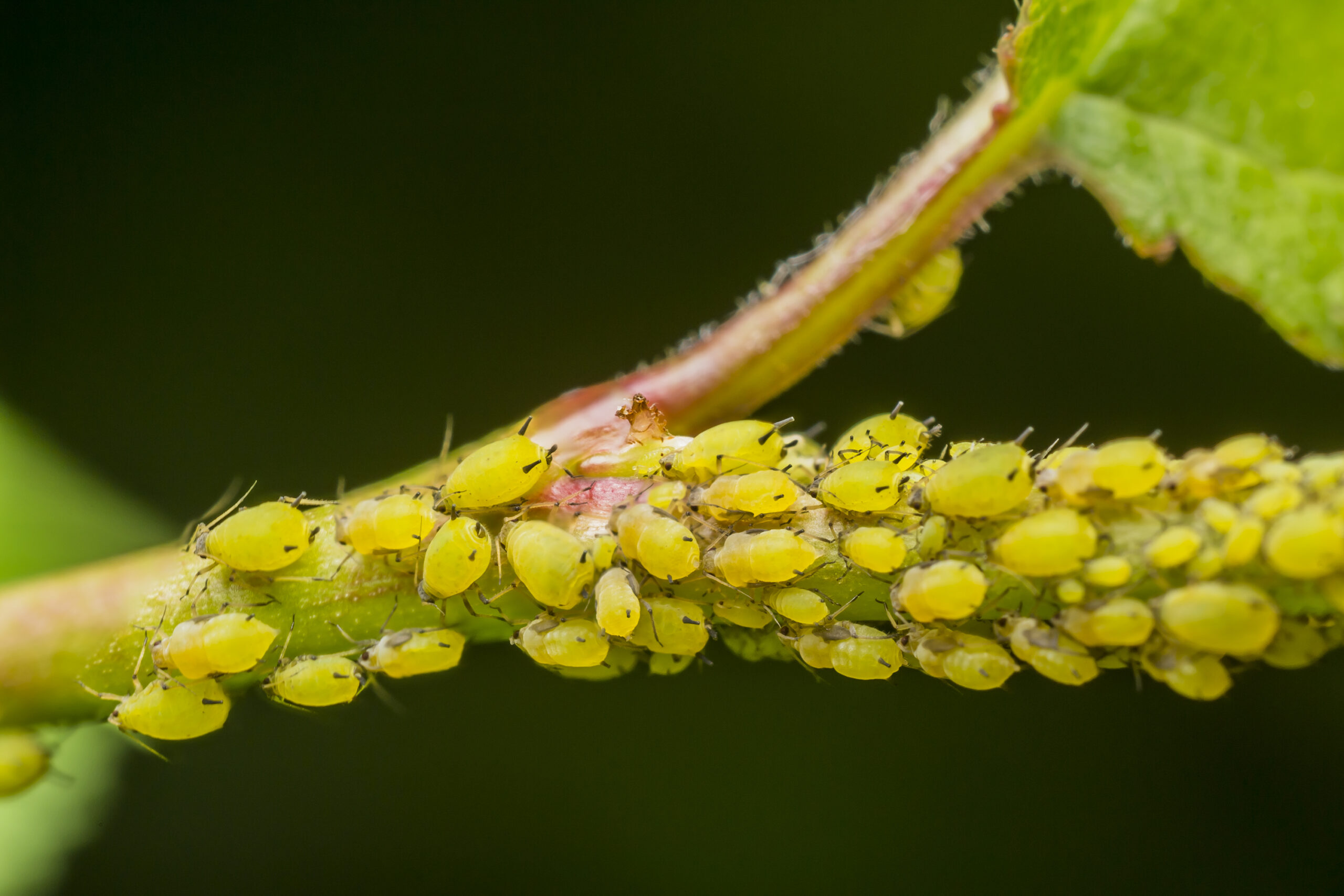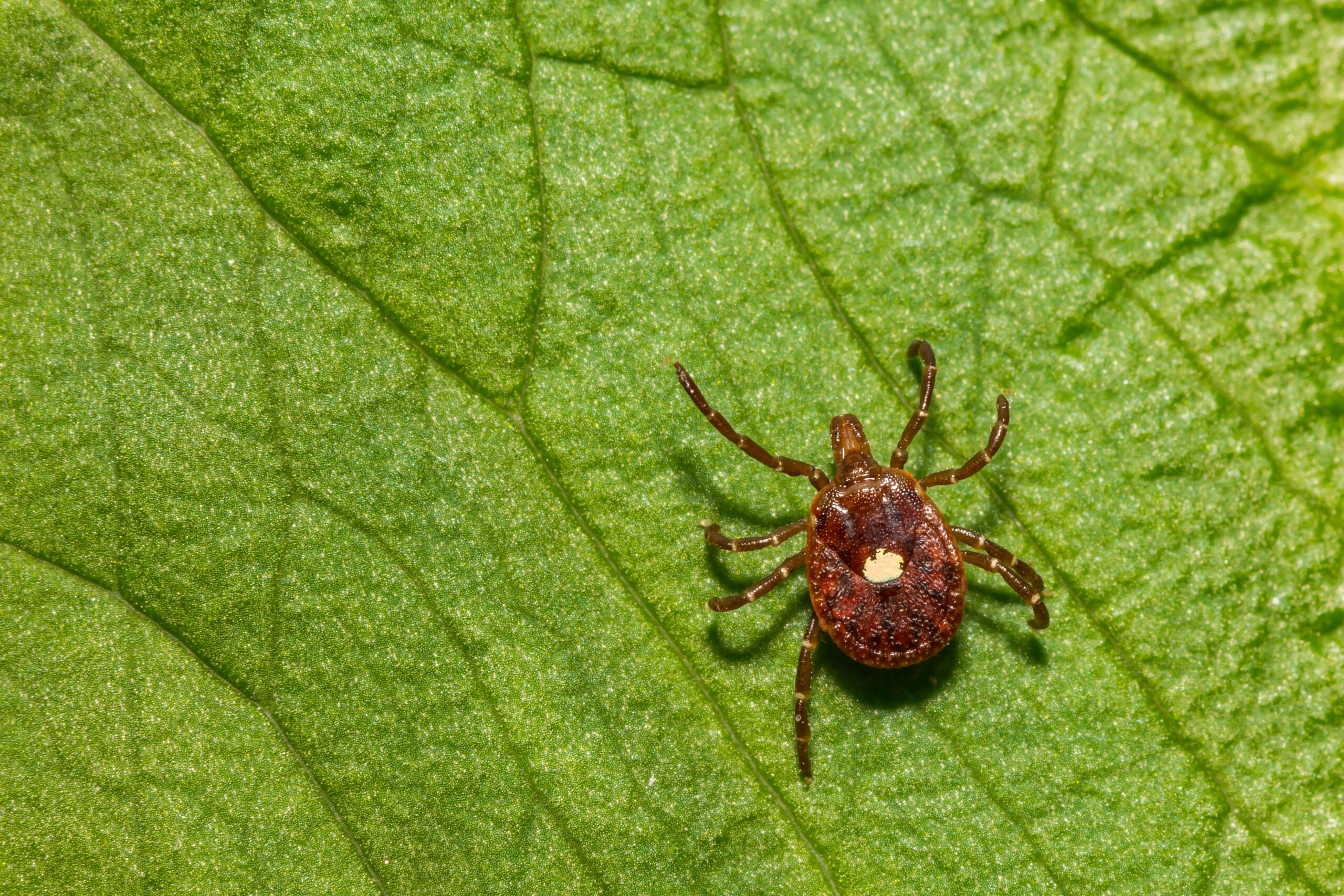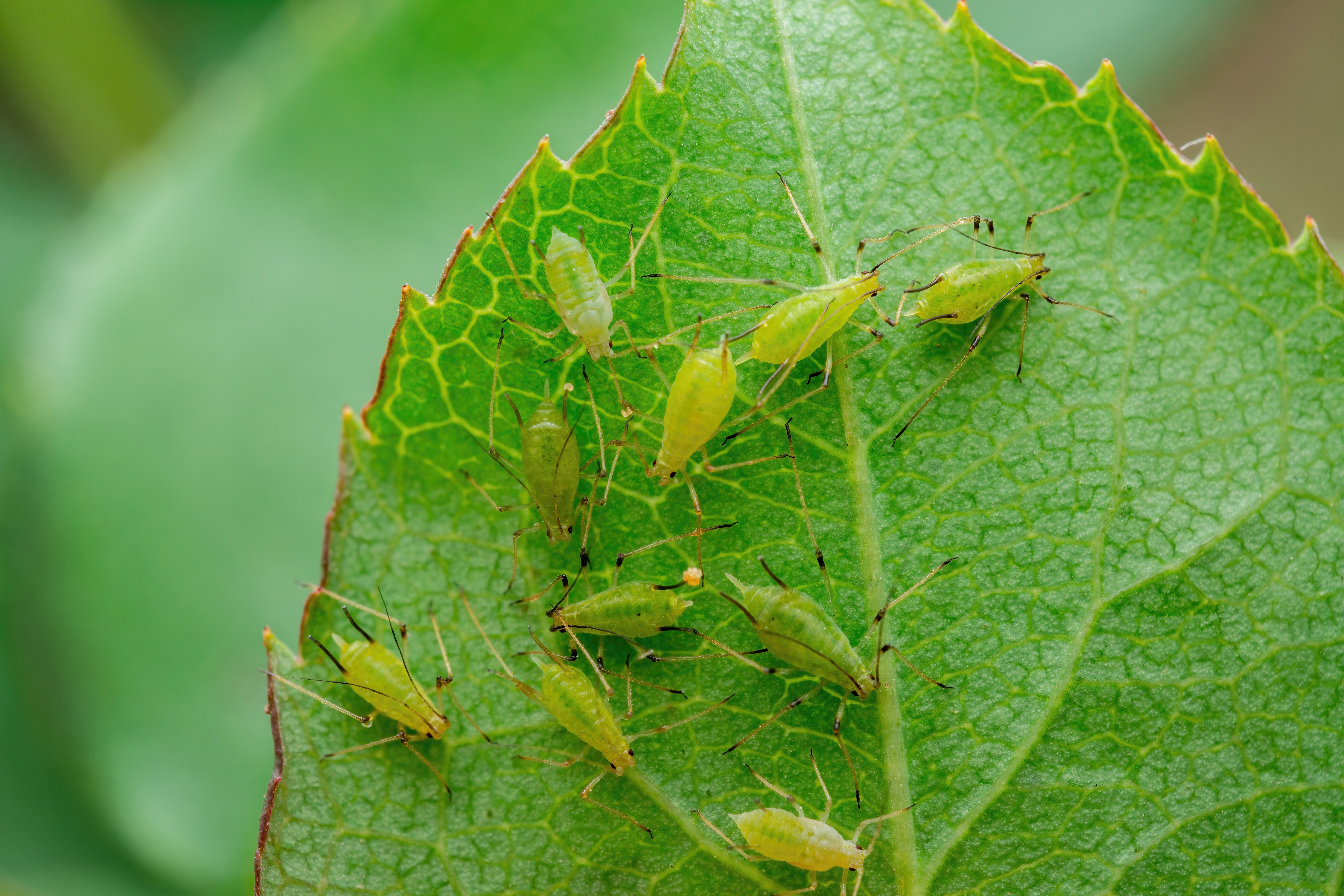The Worst Spring Pests
The Worst Spring Pests
There’s a lot to love about spring: the chirping birds, the blooming flowers, the blue skies, the warm temperatures, and so on. One of the major downsides of this season — besides the abundance of sneeze-inducing pollen — is that insects are also coming out to enjoy the warm weather. Since bugs are ectothermic (cold-blooded), they get their energy from high temperatures and humidity.
You’ll see all kinds of creepy-crawlies this spring, but there are some that cause us problems every single year. Let’s examine 6 of the most frustrating spring pests before we dive into the best ways to prevent them from ruining this growing season for you.
Ants

Ants are technically a year-round pest, but they start to consistently cause problems in the spring. After they go through their winter stash of food, the workers start searching for new food sources in the warm temperatures of spring. Ants are always on the hunt for food because their colonies continue to grow at an impressive rate. Queen ants don’t stop laying eggs as long as they’re fed and healthy.
Humans unintentionally make it easy for these pests in the spring, what with our picnics and outdoor parties. Any crumbs and opened food are easily accessible to ants, so it’s important to clean up after you enjoy a meal outdoors. Don’t underestimate the importance of keeping a tidy kitchen as well; ants are found here when they have access to an all-you-can-eat buffet in your pantry!
Aphids

When we think of spring, the image of a beautiful garden springs (get it?) to mind. Unfortunately, aphids are on the same page and set their sights on our plants as soon as the sun warms them. These pests mainly target flowers, fruits, and vegetables, but they can feed from a wide variety of plants. Aphids have piercing mouthparts that they stick into leaves to access the hidden sap. Both new and young plants are the most impacted by aphids since they don’t have the strength to fight back.
The most evident sign of an aphid invasion is if a plant’s leaves start wilting, yellowing, and dropping seemingly out of nowhere. They also produce drops of honeydew as they feed, which causes two major issues. One is that honeydew invites sooty mold and plant diseases to the greenery before long. The other issue is that ants love honeydew and “farm” the aphids by moving them to different plants in order to get more of that sweet substance.
Mosquitoes

Often regarded as a summertime pest, mosquitoes will start their frustrating habits in spring if it’s warm enough. They are active once the temperature is consistently above 50° Fahrenheit, so an early spring can coax mosquitoes out of hiding. The one essential mosquitoes need for their eggs is moisture. The more it rains, the more places mosquitoes can lay their eggs once the temperature reaches their minimum.
Female mosquitoes lay their last eggs in the fall because the cases are tough enough to survive the frigid winter. These eggs hatch during the first warm stretch of spring, then the young mosquitoes spend the majority of their lives in the same water source. Adult mosquitoes feed on the nectar of nearby flowers, so they have plenty of food sources in the spring. Female mosquitoes gift us with those itchy bites when they need protein for their eggs, but this usually isn’t a major problem until we get further into spring.
Stinging Insects

Similar to mosquitoes, stinging insects are more active in the summer due to the high temperatures. But they’re active in spring once the flowers start blooming and the sun is consistently shining on the plants. Queens start laying eggs and building their nests to prepare for their growing colonies.
Many hornets, bees, wasps, and yellow jackets enjoy flower nectar and start working in spring as soon as they come of age. Worker bees and wasps are usually found near flowers because of this. They gather nectar and pollen to feed the rest of their colonies and sustain the queen while she continues to lay eggs. They pollinate the same flowers by naturally collecting pollen on their striped bodies and accidentally depositing it onto the next flower they visit.
Stink Bugs

Stink bugs aren’t always included in the conversation about spring pests, but they should be since they’re one of the worst garden pests ever. Stink bugs are more of an issue in the dead of summer, but spring is the time of their emergence. They start moving out from the structures they invaded before winter once the sun warms the interior enough.
Their primary objectives in the spring are to eat and reproduce, both of which cause ongoing issues for people. They feed on plants, fruits, and vegetables. Stink bugs don’t spread diseases, but they ruin any produce they eat by giving the crops tissue damage. The smelly chemical that gives stink bugs their name is produced as a spray when they feel threatened. It’s stored in a gland and launches several inches away, and the strange smell (similar to ammonia or cilantro) deters predators from eating these pests.
Ticks

Spending time in nature is great for the soul, but the good feeling is quickly squashed when a tick finds a new food source in our blood. They hide in tall grass and wooded areas, waiting for a mammal to walk close enough for the tick to walk onto their new host. Since everything is growing again, ticks have even more hiding spots to choose from in between feedings.
Black-legged ticks, American dog ticks, and lone star ticks are the most common this time of year. Once a tick is comfortable on a person or animal, it will feed until it’s engorged with the warm blood. This pest needs to continuously feed for at least 36 hours to transmit a disease (if it’s contaminated) to its host. Lyme disease and Rocky Mountain spotted fever are likely the most well-known diseases spread by ticks. These pests are ready to start feeding again, so use caution while hiking and don’t go off the trail into overgrown brush.
How To Prevent Spring Pests

To put it bluntly, the best way to prevent spring pests is to be prepared. We know that bugs are a common presence this time of year, so the most efficient way to stop them from taking over your life is to stay one step ahead of them. Between removing their habitats and eliminating their food sources, it’s entirely possible to reduce the number of pests bugging you this spring.
In our humble opinion, the best ways to prevent springtime pests are:
- Seal all cracks and gaps in your house’s exterior. Waterproof caulk and steel wool are the best materials for this project.
- Check all window and door screens for rips before opening up the house. Smaller holes can be patched with extra material, but it’s best to replace the entire mesh screen if there are a lot of gaps.
- Apply a bug spray to any exposed skin (besides your face) before spending hours outside. Make sure the spray has DEETs since these ingredients actually keep bugs away.
- After hiking or doing yard work, check yourself (and family members) for ticks. They like to hide around our necks, chests, waists, and ears.
- Keep up with your yard work as the plants and trees begin to blossom again. Trim back every plant and tree from the house by at least one foot, and remove all weeds surrounding the plants.
- Empty out collected water from yard objects after a rainstorm. Buckets, tarps, children’s toys, and plant drainage trays all serve as mosquito breeding grounds when they’re full of water!
- Keep the plants watered but not overwatered. Healthy plants are often pest-free plants, so having a watering schedule should protect plants from drought and invasions.
- Check around your house for any stinging insect nests. Most of them like to keep their nests elevated (eaves, sheds, playgrounds), but yellow jackets prefer to nest on the ground.
- If you have cats or dogs who spend a lot of time outside, consider giving them flea and tick treatments. Your vet should have all of the information on these preventative treatments.
Go Green This Spring!
Above all, the most efficient way to keep the pests out of your home and away from your yard is with preventative pest control. The licensed technicians of Green Pest Services are dedicated to reducing the spring pest population as much as possible. After we thoroughly inspect the property for all signs of pest activity, we create a treatment plan that targets each current pest and prevents future ones. We want you to feel completely comfortable with the services being done for your home, so our team is happy to address all questions and concerns you have along the way. Contact us today for a free quote on our efficient services that will put the spring back in your step!
Citations
Hill, C. (2019, November 7). The 15 most dangerous springtime pests and problems. AccuWeather. Available at https://www.accuweather.com/en/weather-news/the-15-most-dangerous-springtime-pests-and-problems-2/371150 (Accessed on March 18, 2024).
Kraft, S. & Pinto, L. (2024, March 14). Early spring mosquito problems. Pest Control Technology. Available at https://www.pctonline.com/news/early-spring-mosquito-problems/ (Accessed on March 18, 2024).
Stink bugs. (n.d.). Pointe Pest Control. Retrieved March 18, 2024, from https://pointepestcontrol.com/services/stink-bugs/
Waterworth, K. & Saddler, L. (2022, September 26). 7 common spring pests and how to control them. Forbes Home. Available at https://www.forbes.com/home-improvement/pest-control/common-spring-pests/ (Accessed on March 18, 2024).
8 Creative Ways to Have a Pest-Free Fourth of July
8 Creative Ways to Have a Pest-Free Fourth of July 8 Creative Ways to Have a Pest-Free Fourth of July Summary: The Fourth [...]
A Simple Guide to Preventing Stinging Pests
A Simple Guide to Preventing Stinging Pests A Simple Guide to Preventing Stinging Pests Summary: Stinging insects are more active in warm weather, [...]
These 10 Natural Mosquito Repellents Can Actually Help
These 10 Natural Mosquito Repellents Can Actually Help These 10 Natural Mosquito Repellents Can Actually Help Summary: Natural mosquito repellents are easier to [...]
How to Get Rid of Carpet Beetles
How to Get Rid of Carpet Beetles How to Get Rid of Carpet Beetles Summary: Carpet beetles are sneaky pests that don’t usually [...]
How Do Roaches Affect Asthma and Allergies?
How Do Roaches Affect Asthma and Allergies? How Do Roaches Affect Asthma and Allergies? Summary: It’s no secret that pests impact human health, [...]
These 5 Carnivorous Pests Might Surprise You!
These 5 Carnivorous Pests Might Surprise You! These 5 Carnivorous Pests Might Surprise You! Summary: There are many eco-friendly ways to prevent pests, [...]

